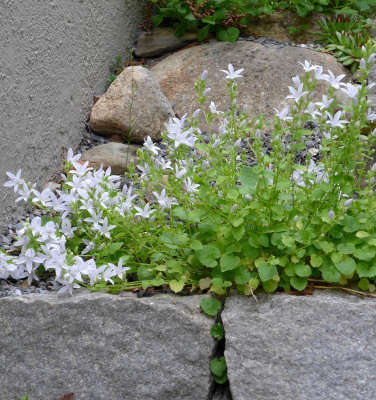

Bellflowers are the quintessential cottage garden flower, with distinctive bell-shaped flower cups (their horticultural name, Campanula, is Latin for “little bell”) belong near the front of border where they can keep company with geraniums, day lilies, and coral bells.
Excellent cut flowers, bellflowers will re-bloom during the summer after you deadhead them. (On the taller varieties, remove individual faded flowers to promote more blooms; when all the flowers are finished, you can cut back the flowering stalks to the base.) There are more than 300 cultivars in the bellflower family— including annual, biennial, and perennial varieties— in a wide selection of colors and sizes; don’t overlook the low creepers such as Dalmatian bellflower (Campanula portenschlagiana syn. C. muralis), which make charming ground covers.
v5.0
When you register as a free Member of the Remodelista family of websites (Remodelista, Gardenista, and The Organized Home), you gain access to all current posts plus 10 archived posts per month, our internal bookmarking tool, and the community bulletin board.
Member benefits include:
For $5/month ($59.99 paid annually) you'll enjoy unlimited, ad-free access to Remodelista, Gardenista, and The Organized Home and all the benefits of Membership.
Subscriber benefits include:
For $5/month ($59.99 paid annually) you'll enjoy unlimited, ad-free access to Remodelista, Gardenista, and The Organized Home and all the benefits of Membership.
Subscriber benefits include:
Benefits include:
For $5/month ($59.99 paid annually) you'll enjoy unlimited, ad-free access to Remodelista, Gardenista, and The Organized Home and all the benefits of Membership.
Subscriber benefits include:
When you register as a free Member of the Remodelista family of websites (Remodelista, Gardenista, and The Organized Home), you gain access to all current posts plus 10 archived posts per month, our internal bookmarking tool, and the community bulletin board.
Member benefits include:
If at any time you want to become a Subscriber and enjoy unlimited, ad-free access to all our content, just go to the My Account link and choose Subscribe.
Advertising funds our work at Gardenista and helps us provide you with a daily dose of garden inspiration & design. We hope you’ll consider disabling your adblocker for Gardenista so we can continue our mission: a well-designed garden for all.
Thank you for your support.